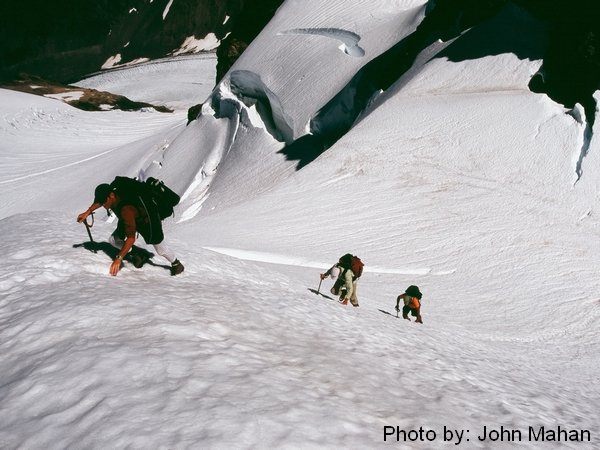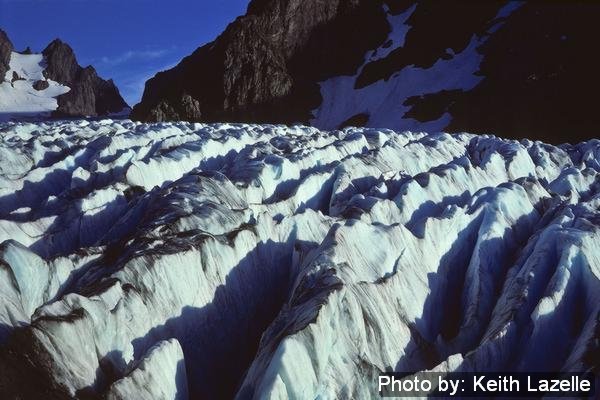The Crown Jewel of the Olympics
The grandeur of the mountains is evident throughout the entire 923,000 acres of Olympic National Park. The most spectacular example of all is Mount Olympus and the Hoh River Valley.
The moment I saw some old photos of this remote, glacier-covered peak, I knew that I wanted to climb it. I was a back country skier living in Vermont at the time, and the images of year- round snow and sharp rugged peaks drew me in like a moth to a flame.
Convinced that this place was the high country of my dreams, I moved across the continent to Port Angeles. My goal was to explore the possibility of turning these images into actual experiences. I was so focused on reaching this alpine playground, that I did not foresee a journey through such beautiful and diverse natural worlds.
I had lived in town only a month when I put together a trip for the two days I had off for the fourth-of- July holiday. My goal was to ski from as high up the mountain as possible. I had no idea how ambitious this trip plan was – after all it was “only” a 42 mile round- trip hike.
I was new to the Olympics but not to hiking. I had hiked the entire Appalachian Trail in 1985, and that is where I met my Port Angeles connection, Steve Teufert. He had local experience but was unable to go and suggested that I team up with someone to be safe, especially on the mountain. I quickly agreed and he introduced me to Robert, who was also new to town.
Arriving at the Hoh River trail after sunset, we quickly set off the approaching darkness. My anticipation of the upper reaches of the hike kept me from realizing just how amazing my surroundings were as we hiked a short three miles before making camp. I was simply happy to be on my way.
Setting out at first light the next morning, however, I soon realized that there was more to this valley than an approach hike to a mountain. As the sun rose higher into the sky, we were greeted by a thousand shades of green. Trees of gigantic proportions created a mesmerizing scene.
Shafts of light descending to the valley floor invited me forward, deeper into this living cathedral. Douglas fir, western red cedar, and Sitka spruce dominated the forest. Some of the largest trees of several species are found here, including an amazing western red cedar that is more than 60 feet around at it’s base.
I began to think of not only the history of hiking in the Hoh valley and the summit attempts of Mount Olympus, but also of the hundreds of years that these trees had experienced. Individual cedars can grow for 1,000 years, and Douglas fir can live for 700 years!
This was my first encounter with an old-growth forest, and my amazing surroundings carried me up the valley. The flat valley miles clicked off behind me. My arrival at the High Hoh Bridge, a dramatic 150 feet above the river, marked the beginning of the real work of climbing the mountain.
The trail gained less than 800 feet during the first 13 miles, and the lush rain forest remained a constant companion. But that was about to change. There are several zones of vegetation that you hike through on your way to the mountain. The effect is of traveling 100 miles to the north for every 500 feet of elevation gained.
We passed on a quick dip into Elk Lake in an effort to get to the base camp of Glacier Meadows. I soon regretted not taking advantage of the cool water and now I always stop for a swim before taking on the final steep 2.5 miles to camp. It was during this stretch that the elevation change really became noticeable as we hiked through the montane zone and approached the subalpine.
I carried a heavy pack with the combined weight of ski and climbing gear, and had made the decision to leave the tent and “sleep under the stars”. I had difficulty sleeping under the star filled skies as I was filled with the anticipation of my first glacier experience.
The sky had barely begun to lighten when I was up and ready to begin the day. The first mile was painful as my legs tried to recover from the previous day’s effort. Seeing mountain goats just 200 hundred yards away made me feel like I had entered into their world. It seemed that they were amused at my feeble pace.
But then the moment that I had been waiting for arrived in stunning fashion. We topped the moraine and were rewarded to the view of the mountain. Blue Glacier lay still in the shade several hundred feet below. And glowing in the early morning sun was Snow Dome and the summit of Mt. Olympus 3,000 feet above. This is what I had come for, and I suddenly felt in my element. I will never tire of this view and will continue to make this trek for the glory of this moment alone.
The coolness emanating from the ice of the glacier added to the experience of what felt like a walk in a moonscape. I was naive that first trip and just flew across the broken ice, leaving Robert to chase me down. I now know that many climbers have sprained ankles and even broken legs on the lower Blue Glacier, and that it should negotiated with care.
As we were heading up the main route after crossing the mostly flat glacier, the terrain became steep and I was finally happy that I had carried my skis. What I didn’t realize was that we were climbing the Snow Dome, which averages 300 inches deep and has been drilled as deep as 1,000.
While the average rainfall at the Hoh Ranger Station is 140 inches a year, Mt. Olympus receives the equivalent of 240 inches. Because the precipitation is measured in rainfall, the upper reaches of the mountain receive as much as 100 feet of snow!
On that first climb, I imagined what it must have been like to try this event 50 or even 100 years earlier: to be a pioneer climber of the mountain. I had entered the world of the old photos that drew me here.
It was easy to imagine that there had never been an ascent before the one that I was undertaking. The snow and ice were trackless. There was no one else on the mountain. The feeling was of being a Mount Olympus pioneer.
I have since come to realize that it is not unusual to be on a Mount Olympus summit adventure with no other climbing parties on the mountain. Although it is the third most glaciated peak in the continental United States (behind only Mount Rainier and Mount Baker), it is sufficiently remote enough to record fewer summit parties all summer than Mount Rainier can have during a single busy weekend.
We soon realized that our time was running out and we spent 20 minutes eating and cursing ourselves for our two- day schedule. We decided on going up the direct route and hoped for the best.
The steep slope was intimidating, and as when we skirted around a deep crevasse, I knew that I would be starting my ski run below that point. We came across another more substantial opening, and although the summit block was just within reach, our time was up and we needed to descend.

Approaching the Summit
When we paused to take in the views, our efforts were richly rewarded. Only 35 miles to the west, the Pacific Ocean shone a sparkling gold. In every other direction, mountains and valleys spread below. The Olympics stood in stark detail, and the neighboring ranges clearly visible in the distance.
Seeing the Coastal Range in Canada to the north and the volcano images of Mt. Baker and Mt. Rainier to the east, we were content with our destination. Even though climbing to the rocky summit had not been achieved, the spirit of adventure had been fulfilled.
As this satisfaction set in, I realized this was only the half way point. Now I would get to ski down the 3,000 feet that I had just climbed, excluding the huge gap that I needed to down- climb around. Putting my skis on while clinging to a 50-degree slope proved spooky, but once this was accomplished, the pitch eased and the challenging terrain added to the experience.
I wasn’t sure that skiing would be easier than glissading, especially when Robert sat down and slid down the slope. My legs burned from the effort of the approach and the effect of skiing 12 inches of slush. But the pain took a backseat to the joy of carving turns down the Snow Dome, and the effortless glide across the Blue proved a delight while Robert had to renegotiate the icy terrain on foot.
I was sorry to leave this mountainous world, but we had to keep moving. Back in the valley, I once again found myself in the most incredibly lush surroundings. It all seemed surreal, and my recurring thought was “How could all of this be in one place?”
At the time I thought “What a special place.” After 16 years and several summit visits, I now know how absolutely special this place is. For the incredible forest and spectacular peak at the upper end, the Hoh River Valley and Mount Olympus make this a very special climbing experience.
This essay was originally published in Fast Moving Water Images and Essays from the Hoh River in 2008. Photos in the book are by photographer Keith Lazelle.

